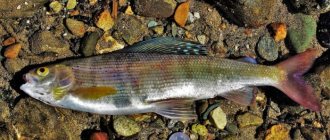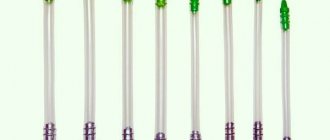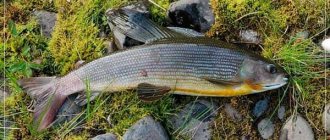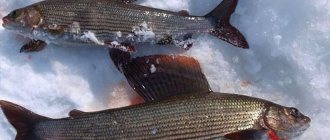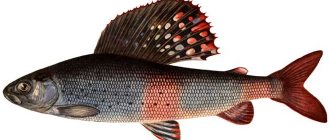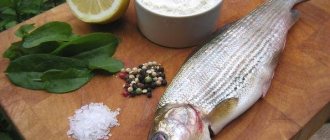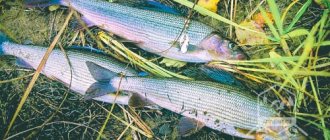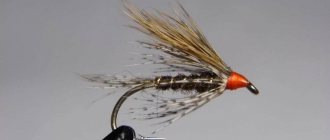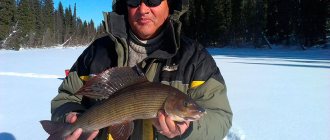The rivers of the Krasnoyarsk Territory - cold, clean, with a rocky bottom, rifts, rapids, shallows and deep holes - amaze the imagination with the variety of fish that live in them. But it is grayling fishing that is considered the most popular and exciting activity.
Grayling fishing in Krasnoyarsk is interesting because the fish in the reservoirs vary in size and color. In autumn and spring in the Angara and Yenisei you can find large black Baikal grayling, which is an anadromous species. Its weight reaches 1.5 kg. The weight of the local Siberian species (Krasnoyarsk residents call the fish “white grayling”) rarely exceeds 300 g, but it is its meat that local residents consider the most delicious. True white Baikal grayling, weighing more than 1 kg, also enters the rivers of the region.
If you have high-quality equipment and a certain skill, success is guaranteed. An important question remains - where to catch grayling.
Promising fishing spots
The leader, of course, is Yenisei. A mighty river flows through the entire region. Krasnoyarsk is located in the deep valley of the Middle Yenisei. The river divides the city into two parts. The most popular place among local fishermen is the southern coast of Otdykha Island, the Abakan Channel.
If you cast your tackle further from the shore, you can catch good specimens of grayling:
- on the embankment near the river station;
- near Tatyshev Island in the main channel of the Yenisei;
- on the left bank of the river near the Korkinsky Bridge, better known as the “Three Sevens”.
You can go fishing in Krasnoyarsk and its surroundings not only on the Yenisei. The rivers Kacha, Mana, Berezovka, Cheryomushka, Bolshaya and Malaya Sliznevo, Bazaikha and its left tributary, the Kuzmichev stream, are rich in grayling.
The Chulym River is considered a fishing mecca. It does not flow into the Yenisei, and throughout the entire route through the Krasnoyarsk Territory it looks like a stormy mountain stream. People go to Chulym for trophy specimens of grayling, lenok, nelma, and taimen.
The choice of fishing spot is influenced by the season. In the spring and until the end of spawning, as well as in winter, grayling stays mainly in bottom holes, which are especially numerous in the area from Krasnoyarsk to the village of Atamanovo. It is not difficult to identify such a depression in the water: next to the main fast current there is a stream with a slower current. Approximately halfway between them you need to throw the tackle: grayling usually stands on the edge of the holes.
At the beginning of July, the fish come out to open water. At this time, Krasnoyarsk fishermen catch it all over the Yenisei: from the shore with a “balda”, “hangarka”, less often with a spinning rod, from a boat - with a “pokatukha”.
You can catch grayling almost all year round: starting from the Krasnoyarsk hydroelectric power station and 150–200 km below the city, the Yenisei does not freeze in winter.
Grayling habitat
Grayling belongs to the salmon suborder family. The size of the bulk of grayling is 25 – 35 cm with a weight of 0.5 kg, but there are some “trophy” specimens reaching 55 cm and weighing 1.5 – 2.0 kg. A distinctive feature of grayling is its dorsal fin with 17 rays. This species prefers to live in lakes and rivers with rocky bottoms and cold, clear water.
There are 4 types of grayling in Russia:
- Siberian;
- Kosogolsky;
- Mongolian;
- ordinary.
Siberian has 4 subspecies:
- Kamchatka;
- Baikal;
- Amur;
- North Aleutian.
The food for grayling are insect larvae, crustaceans and fish fry. Spawning takes place in the spring months (mid-May), when females lay eggs on rocky soil in the amount of 3–10 thousand eggs. For habitat, grayling chooses rivers and lakes with clean water.
In Krasnoyarsk and the Krasnoyarsk Territory, the Yenisei is mainly inhabited by the West Siberian subspecies with a wide dorsal fin, colored in the form of large spots with a metallic tint. Grayling rarely migrates and prefers settled, familiar habitats.
The main food for grayling are: insect larvae, caddis flies, crustaceans, stoneflies, fish eggs and fry of various species.
Fishing with a bulldozer
Behind the funny name lies the legendary Siberian tackle, which is considered by Krasnoyarsk fishermen to be the most catchy when hunting for grayling.
Unlike the classic “balda”, consisting of a sinker and a pair of hooks decorated with beads, the Siberian version has a more complex installation. The structure consists of the following elements:
- a pear-shaped or elongated load weighing from 40 to 80 g (depending on fishing conditions and current speed);
- “setup”, which is a piece of fishing line with loops for 2-4 flies, tied on leashes up to 10 cm long. The length of the “setup” is usually from 0.5 to 1 meter. It is attached to the main thread using a carabiner;
- durable monofilament line, 0.20 mm thick (it is better to discard the cord: it is noticeable in the water, and grayling is careful);
- a hook with an artificial fly or bait for each leader;
- a massive sliding float (aka “balda” or “float”) corresponding to the weight of the load. A stopper (for example, a bead) is mounted above the float;
- inertial coil.
The high efficiency of fishing with the “buldo” is based on knowledge of the habits of grayling. In a large, full-flowing river (Yenisei) or in rapids and turbulent reservoirs (Mana River), grayling rarely approaches the very shore. The “balda” tackle allows you to cast even light baits far. The fish prefers to stay near the bottom. The dropped load creates a small cloud of turbidity around itself, which attracts grayling.
The fisherman throws the tackle upstream and begins to slowly pull in the line. The load moves along the bottom, as if “tapping” it (according to one version, it was precisely because of the characteristic sound that the tackle received the name “bulda”). At the same time, the large float rests against the stopper, and the leashes with the nozzle move to the sides. The float is slowed down by the weight, and the flies, without sinking to the bottom, swim with the flow slightly ahead of the target. The omnivorous grayling has complete control over its water area and rushes at any insect that falls into the water. The main thing is not to miss the bite.
When fishing for grayling on a bulldozer, fishermen advise braking the reel with your thumb: this allows you to control the position of the load (“listen to the bottom,” as Krasnoyarsk residents say) and react in time to a bite.
Fish biting forecast in Krasnoyarsk, Krasnoyarsk Territory
| Weather forecast and fish bite | Krasnoyarsk, from 02/16/2021 to 02/19/2021 | |||||||||||
| VT | SR | Thu | PT | |||||||||
| Times of Day | Evening | Night | Morning | Day | Evening | Night | Morning | Day | Evening | Night | Morning | Day |
| Cloudiness, precipitation | Mainly cloudy | light snow | light snow | light snow | Mainly cloudy | Mainly cloudy | Mainly cloudy | Mainly cloudy | Mainly cloudy | Mainly cloudy | light snow | light snow |
| Temperature °C | -1 | -2 | -2 | 0 | -12 | -14 | -15 | -14 | -18 | -18 | -17 | -13 |
| Pressure, mm. | 760 | 759 | 757 | 759 | 765 | 767 | 767 | 769 | 769 | 763 | 758 | 753 |
| Direction, | Wind southwest | South wind | Wind southwest | West wind | West wind | Wind southwest | Wind southwest | West wind | West wind | Wind northeast | East wind | East wind |
| wind speed | 4 m/s | 1 m/s | 3 m/s | 8 m/s | 3 m/s | 2 m/s | 3 m/s | 4 m/s | 1 m/s | 2 m/s | 3 m/s | 2 m/s |
| According to the forecast, they will bite on: bloodworms crucian carp | 45% | 0% | 55% | 55% | 45% | 0% | 55% | 55% | 45% | 0% | 40% | 40% |
| According to the forecast, they will bite on: bloodworms Carp | 20% | 0% | 20% | 20% | 20% | 0% | 20% | 20% | 20% | 0% | 5% | 5% |
| According to the forecast it doesn't bite Silver carp | 0% | 0% | 0% | 0% | 0% | 0% | 0% | 0% | 0% | 0% | 0% | 0% |
| According to the forecast it doesn't bite Carp | 0% | 0% | 0% | 0% | 0% | 0% | 0% | 0% | 0% | 0% | 0% | 0% |
| According to the forecast, the fish will bite on: live bait (jigs), winter spinners, balancers Pike | 65% | 25% | 75% | 75% | 65% | 25% | 75% | 75% | 65% | 10% | 60% | 60% |
| According to the forecast, they will bite on: bloodworms, winter spoons, balance beams Perch | 55% | 0% | 65% | 65% | 55% | 0% | 65% | 65% | 55% | 0% | 50% | 50% |
| According to the forecast, the fish will bite on: live bait, winter spinners, balancer Zander | 55% | 55% | 65% | 45% | 55% | 55% | 65% | 45% | 55% | 40% | 50% | 30% |
| According to the forecast, they will bite on: bloodworms, maggots, bark beetles, burdocks Dace | 40% | 35% | 50% | 50% | 40% | 35% | 50% | 50% | 40% | 20% | 35% | 35% |
| According to the forecast, they will bite on: bloodworms, maggots, bark beetles, burdocks Ruff | 40% | 35% | 50% | 45% | 40% | 35% | 50% | 45% | 40% | 20% | 35% | 30% |
| According to the forecast, the fish will bite on: bloodworms, spoons, balance beams Trout | 40% | 0% | 60% | 45% | 40% | 0% | 60% | 45% | 40% | 0% | 40% | 25% |
| According to the forecast, they will bite on: bloodworms, maggots, bark beetles, burdocks Chub | 40% | 20% | 60% | 45% | 40% | 20% | 60% | 45% | 40% | 0% | 40% | 25% |
| According to the forecast, they will bite on: bloodworms, oparish, spinners Grayling | 40% | 0% | 60% | 45% | 40% | 0% | 60% | 45% | 40% | 0% | 40% | 25% |
| Doesn't bite Asp | 20% | 0% | 30% | 10% | 20% | 0% | 30% | 10% | 20% | 0% | 10% | 0% |
| According to the forecast, they will bite on: maggot, bloodworm Rudd | 40% | 0% | 50% | 50% | 40% | 0% | 50% | 50% | 40% | 0% | 30% | 30% |
| Bait: maggot, bloodworm Bream | 40% | 55% | 50% | 40% | 40% | 55% | 50% | 40% | 40% | 35% | 30% | 20% |
| Bait: worm, live bait, spinner Burbot | 80% | 90% | 80% | 50% | 80% | 90% | 80% | 50% | 80% | 70% | 60% | 30% |
| Bait: maggot, bloodworm Roach | 55% | 0% | 75% | 65% | 55% | 0% | 75% | 65% | 55% | 0% | 60% | 50% |
| Bait: maggot, bloodworm Bleak | 40% | 0% | 50% | 50% | 40% | 0% | 50% | 50% | 40% | 0% | 40% | 40% |
| Bait: maggot, bloodworm, bark beetle Ide | 30% | 0% | 40% | 30% | 30% | 0% | 40% | 30% | 30% | 0% | 20% | 10% |
| Bait: no Som | 0% | 0% | 0% | 0% | 0% | 0% | 0% | 0% | 0% | 0% | 0% | 0% |
Meanings of symbols and colors of the bite forecast table
| Mon | Monday |
| Tuesday |
| Wednesday |
| Thursday |
| Friday |
| Saturday |
| Sunday |
| Probability of a bite in % (from 0 to 100) |
Krasnoyarsk "hangarka"
Another effective tackle for catching grayling on the Yenisei and its tributaries is the riding gear. Fishermen of the Krasnoyarsk Territory call it “hangarka”. It is similar in structure to the “boom”, but the float consists of two parts. The top one is made of floating material: wood, cork, foam. The lower one is loaded with lead.
For hangar fishing, a spinning rod 2.7–3 meters long, equipped with a spinning reel, is used. The tackle is thrown from the shore directly into the main stream of fast current (threshold, riffle), after which it is smoothly released in an arc. The flies or other baits remain on the surface. The line is slowly reeled in, constantly held in tension, until the tackle is carried to the shore.
In Krasnoyarsk, grayling is caught using various types of donks
You can catch grayling in the Krasnoyarsk Territory not only using local methods. A regular float rod with bait in the form of maggots, larvae or a worm is quite suitable. Visiting fishermen successfully use a spinning rod with an inertial or multiplier reel, a rigid action and a cast of 70–80 g.
For grayling on the Yenisei
Start here
We are leaving the city 50 km away. Immediately the real wilderness begins. No cottages, no vacationers, no fishermen. Wild, untrodden banks of the Yenisei. We find a beautiful clearing of snowdrops on the river bank and park for the night. Evening meal, fire, admiring the most beautiful scenery: overhanging cliffs, perfectly rounded pebbles of the shore, harsh taiga around...
Dawn has just broken; we are already gushing through the perfectly clear water of the Yenisei. It's cold, but most importantly there's no rain. Rain is the main scourge of kharyuz fishing. Any rain kills insects and the bite immediately dies down. Moreover, heavy rains instantly muddy the water. Grayling bites very poorly in muddy water. Although there is an antidote for this case: an ordinary float with a worm, maggot, stonefly or perekolomina (stonefly larva). Live bait rules both in muddy water and in cold water. For grayling, the concept of cold water is very flexible. Spawning occurs already at a water temperature of +7 degrees. It's a little warmer now. But it normal.
Grayling is a very active fish and constantly moves throughout the river. Although they claim that large grayling are now all on small rivers, spawning.
I'm leaving the camp downstream. Before lunch we managed to walk 5 km, and it started to rain again. Gradually moving along the river I noticed that it was being caught everywhere. With varying success, but you can catch it almost anywhere. The shore is ideal: small pebbles, or sand with grass, or a coastal road. You walk easily. 2-3 casts and move on. If there is a bite, you fish this area for about 10 minutes. Why don’t local fishermen do this. Mostly they stand still and throw continuously for hours, changing flies. The flies here are works of art. Few people buy them in the store. Most knit themselves. In my opinion, the point is not at all in the quality and uniqueness of the flies, and not in the color of the wound lurex. Grayling is a pronounced migratory fish and the presence or absence of a bite may well be explained by the presence of a school near the shore. We didn’t have a thousand flies in our suitcase, but used literally a dozen. Nevertheless, they caught no less, if not more, than the locals. Half a day before the rain I caught 24 grayling. Everyone was released back to their native element. Too small (150-200g). We decided not to take fish smaller than 25 cm. What is there? For one tooth. And fishing rules prohibit taking grayling less than 23cm in length.
Nevertheless, the quantity of fish was pleasing. If you find promising places with large grayling, and with such numbers, there will be quite a bit of fishing.
The next day of fishing was devoted to studying the “balda” gear. Nothing fancy, the main thing is to balance the gear with the current and depth. In general, the river flow of 10-12 km per hour is the main factor for adjusting the gear. The stronger the current, the heavier the tackle. The bulk is shipped using a Tyrolean sinker. In strong currents, the weight of the Tyrolean reaches 80 grams. Working weights: 50-60 gr. The allowed number of flies is 2 pieces, so the length of the tackle (according to local customs) is literally a meter. This is convenient for long and strong casting. In this case, spinning rods are used at least 4 meters. Thus, the casting range often reaches 100 meters. Working casting length is 60-80 meters. In principle, there is no need to throw it that far. It's easier to find a good place. Such a place is the shore as close as possible to the fairway. Grayling can also be caught in the shallows, but usually small ones. On the fairway, it is not uncommon to catch specimens up to 500-700g, with an average weight of 300-400g. How much can you catch in a day? From a boat on the fairway, local fishermen operate a portion of the bucket. A bad bite is one bucket, a good bite is 2-3. But you can fish from a boat only after the ban, which lasts here until June 20.
Comparing the tackles Balda, Tyrolka, and Vanka-Vstanka (Tirolka with a float in a single design), I concluded that I like light weights and Vanka-Vstanka tackle the most. Fewer snags on rocks, easier to throw, more sensitive bites. It should be noted that local fishermen, using overloaded weights, fishing line, and highly tested spinning rods, greatly reduce the sensitivity of the gear. In essence, they are caught in a stranglehold. It is quite difficult to see a small bite on heavy tackle, although with light tackle and constant hooking “for ambiguity” the catch increases significantly. Light weights roll downstream faster. At first glance, this is a minus; you have to reload more often. But this is also a huge plus, because the flies seem to be in a more neutral, floating position in relation to the current, playing better, which in the end again increases the catch.
In the absence of a bite, fishermen begin to sort out their flies. As soon as someone bites, the questions immediately arise: what kind of fly? At the same time, everyone unanimously states: when it bites well, it doesn’t matter the sophistication of the flies. Grayling collects everything.
The direction of further fishing is rafting along mountain taiga rivers with fishing for grayling, searching for lenok and taimen.. But this is already the topic of further summer expeditions.. To be continued...
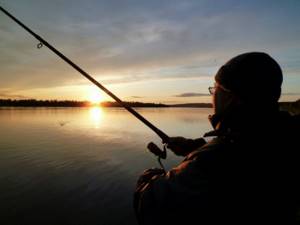
Lures
The Krasnoyarsk hydroelectric power station, built in 1972, changed the food preferences of grayling. This is especially true for fish living in the lower reaches. The riverbed in this area was filled with freshwater shrimp (Angara gammarus), which became a favorite delicacy of grayling. During the feeding season, fish will not refuse bottom caddisflies, stoneflies or mayflies, but gammarus has captured the title of the most catchable bait.
The famous Siberian flies are popular among artificial baits. Krasnoyarsk fishermen consider wet flies with a bright head or ovipositor to be the best. The preferred materials are rooster feathers, animal hair and green lurex. A correctly tied fly completely imitates insects living in a pond.
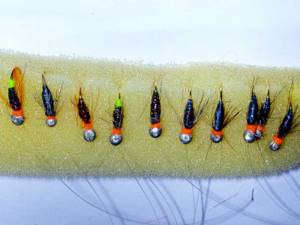
Grayling's attention is attracted by bright flies clearly visible in the water.
Purple cambrics equipped with small beads are also in use. It has been noticed that grayling reacts especially actively to this color.
Grayling fishing in Krasnoyarsk will not disappoint amateurs and professionals. If you don’t want to master local methods, you can use the usual float rod with bait in the form of maggots, larvae or a worm. Visiting fishermen successfully use a spinning rod with an inertial or multiplier reel, a rigid action and a cast of 70–80 g. Grayling fishing will be successful if you stock up on a large number of different baits: the fish is capricious and spoiled by an abundance of food. It is difficult to predict in advance which bait will seduce the Siberian beauty at a particular time of day.
Catching grayling with a spoon in Krasnoyarsk
Rotating spoons of small size, having a varied color of the core and petal, have proven themselves well when fishing for grayling. The best results are achieved when using petals that are colored in the form of bright spots and dots.
For fishing in Krasnoyarsk, it is better to use spinners with the following characteristics:
- accessibility during fishing;
- possibility of use in various conditions;
- wide range of equipment models offered;
- moderate cost of equipment;
- correct response to fish bites;
- natural imitation of insect behavior when moving in a pond;
- high strength and durability during operation;
- highly attractive to fish due to its bright coloring and rotation simulating the activity during retrieving.
The best period for fishing in Krasnoyarsk for grayling in the autumn is considered to be September - October, although fishing can be carried out throughout the year with a short break. In autumn, there is a significant drop in the water level due to which the riffles of reservoirs and deep holes are exposed, which makes it possible to monitor the movement of fish.
Of particular note are the spinners produced by well-known companies producing equipment for grayling fishing:
- Aglia Long No. 00 and Aglia No. 00 from Mepps, which are designed for catching fish weighing 0.15 - 0.3 kg. This type of spinner quickly reacts to the retrieve, creating slight resistance with the rotation of the bait, attracting fish. Good results are achieved by moving the bait along the river. When casting, the spoon is positioned just below the upper water level, which allows it to avoid touching bottom vegetation while simultaneously attracting fish.
- Blue Spark is a universal tackle that is used for fishing depending on the reservoir and time of year. The company offers models painted in colors from black to bright red in various combinations.
- Lukris Spark – rotating spoons designed for fishing for grayling in fast river currents. Due to the elongated petal, the spinner is deflected when moving. Depending on the speed of the current, the spoon dives to a depth of 2 to 3 meters.
- Panther Martin is a lure belonging to the “In-Line” group, with a miniature size, which allows long casts while fishing. The coloring of the models is predominantly from silver-blue to golden-orange in combination with artificial scales applied to the core of the spoon, which creates bright highlights when retrieved, attracting fish.
- Aglia No. 2 from Mapps is one of the most common and popular spinners. Allows you to achieve excellent fishing results with the ability to retrieve at different speeds. The color of the spoon is silver with red side stripes, which attract grayling.
- Heints is a bait that reacts to any movement of water by vigorous rotation. Color: silver or copper color.
When using spinners for grayling fishing in Krasnoyarsk, you also need to choose the right equipment:
- Requirement for a fishing rod : a telescopic rod with a length of 1.8 – 2.4 m, preferably of the “Light” class, with good sensitivity and elasticity.
- The reel is an inertia-free, lightweight reel made of metal with a line reverse stop mechanism.
- As a fishing line, it is better to use a thin thread of 0.12 - 0.16 mm with a total length of 30 m.
- Hooks must be barbless and sharp.
To catch grayling, various bait placement options are used:
- Wiring is carried out against the current, winding the line at a slow pace with periodic stops;
- The bait is cast across the reservoir with the bait being drawn diagonally;
- The bait is thrown against the current. The bait moves due to the energy of the current.
It is also necessary to take into account the characteristics of the Krasnoyarsk reservoir in which fishing is carried out. If grayling swims head up when hunting, then the bait is thrown into the upper layer of water with the ability to move with the flow. The spoon should move, moving slowly, creating the appearance of natural live bait.
Grayling feeding grounds in Krasnoyarsk are also coastal waters near rocks, where various crustaceans, leeches, and larvae live, which are excellent food. In this case, the best option for fishing for grayling is fishing from a boat with casting towards the shore and slow retrieval with periodic pauses.

